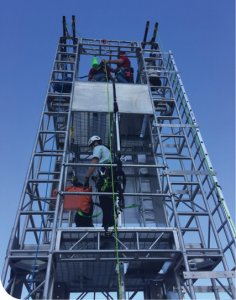
ENSA can bring its portable tower to a job site for training. GWO guidelines for first aid, manual handling, fire awareness, and working at height provide a universal approach to the industry’s global presence.
Independent service providers, those companies that maintain wind turbines at wind plants around the country, generally work under OSHA and ANSI safety standards. But what of the technicians who travel the world maintaining turbines in a different country every week? They would have to work under dozens of different standards. Expecting a person to meet such a mishmash of work requirements might be difficult to justify. Just as ISO works to harmonize worldwide engineering standards, the Global Wind Organization works to equalize wind tech skills in four key areas: first aid, manual handling, fire awareness, and working at height. A fifth area, sea survival, would be added for those working offshore.
It’s a good idea, but how does one earn GWO certificate? Recently, ENSA North America, a division of Mallory Safety & Supply, was approved by Lloyd’s Register Quality Assurance to teach GWO training. “Siemens recognizes its importance, enough to offer the training at their facility in Florida. In fact, a wind technician must be GWO certified if he or she wants to work on a Siemens site,” says Becky Danielson, an instructor and market channel administrator for ENSA. She says to expect more OEMs and owners to require GWO approval.

The class to qualify for working at height work is 16 hours, the first aid module is another 16 hours, the fire prevention session is four hours, and material handling is four hours more.
Danielson points out that earning the approval for a technician is no casual commitment. “For instance, the class to qualify for working at height work is 16 hours, the first aid module is another 16 hours, the fire prevention session is four hours, and material handling is four hours more,” she adds.
After the training, if a tech involved in an incident on the job, that person will know how to manage the situation, and then assist and rescue the victim. These are the criterion that will eventually be a standard.
“Earning GWO approval is a significant accomplishment because the wind industry is rapidly shifting toward it. With GWO approval, techs that come from Spain, Denmark, or Chile, are all trained under the same basic criteria” she says. Which makes it much easier to identify “gap training” necessary to work safely under the local regulatory requirements.
GWO guidelines are a universal approach to the industry’s global presence. Like any other standard, third party auditing will help to insure the GWO BST criteria maintains a level of excellence.
To earn GWO approval for its training functions, Danielson said ENSA had to work through time consuming and extensive ISO 9001 certification which also involved significant cost. “Our GWO certification means we can offer particular training modules that have come over from Europe to which we apply our training methods so we are compliant with both Local and Federal regulations and standards,” she said.
“What’s more, receiving the approval says to the industry that we are not just two people in a training program that recently opened shop. We have received our ISO certification, audited, and our facilities and equipment are audited. Although GWO is a leap for the industry, it will provide peace of mind,” adds Danielson. The GWO standard is freely available on the EWEA website (ewea.org)
Filed Under: News, O&M, Training




